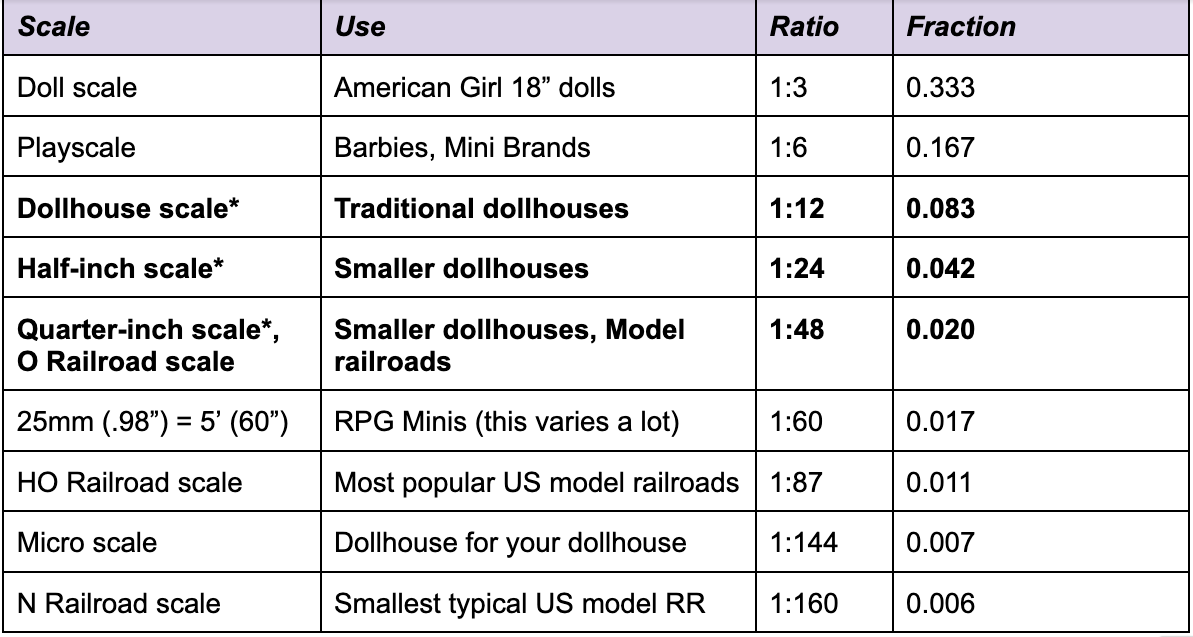|
Even if you don’t know what scale your miniature is, your eye knows when something in a scene is “out of scale”. Your brain knows automatically and instantly. You don’t have to hold it or measure it, you just know. This is what delights us when we see a miniature vignette where everything in it is the same scale. It fools us, even if just for a minute, into thinking we’re looking at something life-sized. To make your miniature scene/dollhouse/diorama look the most “real”, it is important that everything in that scene, from the figures to the furniture to plumbing fixtures to wallpaper, all be the same scale. The scale of a miniature is a ratio; the relative size of the model to the real thing. For example, 1:1 scale ("one to one") would be a life-sized model. 1:10 scale ("one to ten" or “one tenth scale”) would be one tenth of life-sized. 1:100 would be one hundredth of life-sized. The larger the scale number, the smaller the model and the less detail possible. Traditional dollhouse miniatures use 1:12 scale, also known as 1/12, 1”=1’. This means that a 6” figure in your dollhouse would be a 6’ person in your life-sized house, 1/12 the size of the human. Dividing by 12 is tricky in math but it makes scaling for dollhouses convenient if you’re familiar with the imperial system. 1:12 miniatures can have an amazing amount of detail, often with functional gadgets. This is the most common scale you’ll find for dollhouse miniatures. A traditional dollhouse takes up a lot of space in your life-sized house. A 3 story dollhouse fills a tabletop. Two trends have led to the popularity of smaller scales in dollhouse miniatures, particularly 1:24 and 1:48. The first is the diminishing amount of space available for this hobby in a life-sized home. The other trend is the use of new technologies like laser cutting and 3D printing to achieve detail not possible before. 1:24 scale is also known as “half-inch scale” because ½” = 1’. Your 6’ person is now only a 3” doll. You can fit 4 houses on that tabletop! But because our fingers aren’t getting any smaller, we have to use tweezers more and accessories are sometimes just approximate. 1:48 scale is known as “quarter-inch scale” because ¼”=1’. The 6’ person is just a little 1 ½” doll. The drawers on the furniture probably don’t open. You definitely use tweezers to place the objects on the little tables. You can fit a whole village onto the tabletop! Bonus fact: 1:48 for dollhouse miniaturists is approximately the same as “O Scale” for model railroad enthusiasts. The smallest scale commonly used for dollhouse miniatures is 1:144 scale or “Micro Scale”, a “dollhouse for your dollhouse”. Don’t sneeze when you’re working on furniture for these miniatures! If you had a 1:12 dollhouse shop, the dollhouses in that shop would be 1/12 of 1/12 or 1/144 of life-sized. There are other scales used by other kinds of miniature hobbyists. Barbies and Mini Brands are 1:6 scale (called “Play scale”). RPG (Role Play Gaming) miniatures can be around 1:60 for human figures. American Girl dolls are 1:3 scale. Finally, some math. How can you tell what scale your little house or doll is? Measure the length of the little item and divide it by the length of the life-sized item. If you think of it in fractional terms, with 1 in the numerator, you have your scale ratio. It doesn’t matter what measurement system you use, as long as you’re consistent. It is fine to use inches, mm, or hands for both the numerator and denominator as long as they’re the same. Using a calculator to get a decimal number, you can use the following table: Or here are links to a couple of handy online scale calculators:*MiniEtchers specializes in dollhouse furniture kits in 1:24 and 1:48 scales, with some 1:12 scale.
Take a look at my Scale Pinterest Board for more tables and scale comparisons
2 Comments
Your comment will be posted after it is approved.
Leave a Reply. |
AuthorCustom designs as requested by customers Archives
May 2023
Categories |



 RSS Feed
RSS Feed